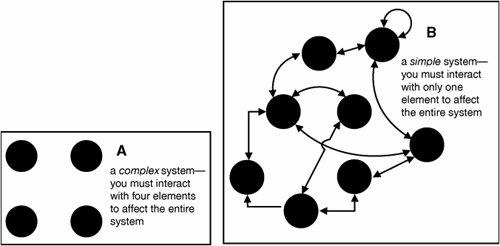Tools
| One way to compare the methods of traditional QFD and TOC is to examine their tools. QFD's Seven Management and Planning (7MP) ToolsThe tool set for QFD comprises the 7 MP Tools (see Figure 24.5) [Mizuno 1988, Nayatani et al. 1994]. Selected from a wide variety of disciplines, these tools are wildly different, ranging from the right-brain no-numbers tool of the Affinity Diagram to the heavily quantitative matrix data analysis chart. So broad is the range they cover that most QFD projects do not use the entire set of tools. The 7 MP Tools translate problems (undesirable effects) to benefits (desirable effects) right away, and then concentrate on focusing on the highest-value benefits. From there the QFD framework is tailored specifically for product development, so there is a great deal of structure to help plan exactly how to deliver the planned value. One theme that all the tools have in common is that they are data driven. The content is produced through data collection, and the results are validated by additional data. In contrast to the TOC tools, there are no well-defined logical checks, and the logic is not strongly scrutinized. Because the tools are data based, they have no requirement that the customers (or the developers) have any experience or intuition. This is most likely to be the case for a brand-new product.
TOC's Thinking ProcessesThe tool set for TOC is the Thinking Processes [Dettmer 1997, Scheinkopf 1999]. These tools (Figure 24.6) share a rigorous use of logic. All the tools examine relationships for either necessity or sufficiency. All the tools share a common structure and syntax. Figure 24.6. The Thinking Processes: the Theory of Constraints tools. The Thinking Processes concentrate on undesirable effects (problems) right away, and only later, after the conflict has been broken, are the desirable effects (benefits) examined. From there the TOC framework provides a general structure to realize the benefits, so there is a great deal of flexibility when planning how to get to any future reality [Schragenheim 1998]. One theme that all the tools have in common is a careful scrutiny of the logic they represent. TOC has well defined "Categories of Legitimate Reservation" that provide a checklist of ways to confirm (or challenge) the logical structure [Scheinkopf 1999]. In contrast to the QFD tools, these tools do not use data, and data is not generally used to check the logic. Because the tools are logic based, they are easier to present, and easier to use for buy-in than most of the 7 MP Tools. The absence of data as a check is perhaps least important when these tools are used for breakthrough results, where current data would hardly be relevant. If your project charter allows for your brand-new product to allow "thinking outside the box," you should definitely consider using Theory of Constraints Thinking Processes on your project. The full Thinking Process Analysis uses all five TOC tools to analyze a situation and identify a core problem, develop a solution, and plan how to implement that solution.
|
EAN: 2147483647
Pages: 394
